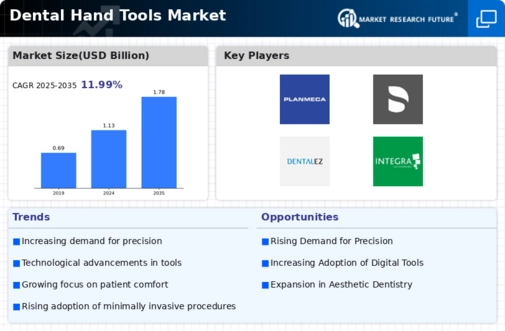Market Trends
Key Emerging Trends in the Dental Hand Tools Market
The Dental Hand Tools sector has been experiencing transformative trends that reflect changing patterns in dental care, as well as an increasing focus on accuracy and ergonomics in dental processes. One significant trend is the increased use of advanced materials in manufacturing Dental Hand Tools. The application of high-quality alloys, ceramics, or advanced polymers enhances the durability, strength, and corrosion resistance of hand tools, which ensures a prolonged lifespan, leading to better performance. There is also an emphasis on the development of ergonomic Dental Hand Tools that can enhance the comfort levels of dentists' working environment, thereby increasing their productivity at work as well as efficiency rates at large (Bamisebi et al., 2017). Ergonomic grips, lightweight design, and intuitive features incorporated within handpieces minimize hand fatigue while enhancing mobility during dental operations. Such a trend acknowledges the importance of ensuring ergonomics that can reduce risks associated with occupational ailments among dental workers, hence improving the overall experience for both service providers and clients. Additionally, advances are being made presently in the way diagnostic instruments are designed and operated within the Dental Hand Tools market segment. Innovations in periodontal probes, explorers, and mirrors intend to provide highly accurate diagnostics faster than before. In addition, it is important to note that the Dental Hand Tools market has a key trend towards digitalizing its products (Bamisebi, 2017). They have incorporated technological advancements in tools such as intra-oral cameras and digital shade guides that enhance visualization and documentation. This shift is part of the general modernization of dentistry whereby practitioners get useful tools for patient education, treatment plans, and complete record keeping. Another important trend is the rise of disposable and single-use Dental Hand Tools. Concerns about infection control and cross-contamination within dental offices have led to the introduction of various disposable instruments, including mirrors, probes, and forceps (Bamisebi et al., 2017). This issue has become particularly significant now that strict infection prevention protocols must be maintained during dental practice with regard to patient safety. Besides this, manufacturers of Dental Hand Tools are beginning to adopt more environmentally friendly practices. Among the eco-friendly materials being explored by suppliers are recyclable packaging and sustainable production processes that diminish the environmental impact caused by making dental hand tools (Maor & Einav-Bachar, 2020). This move aligns with rising awareness regarding sustainability in healthcare coupled with a strong commitment among dental practitioners to minimize their carbon footprint.







Leave a Comment